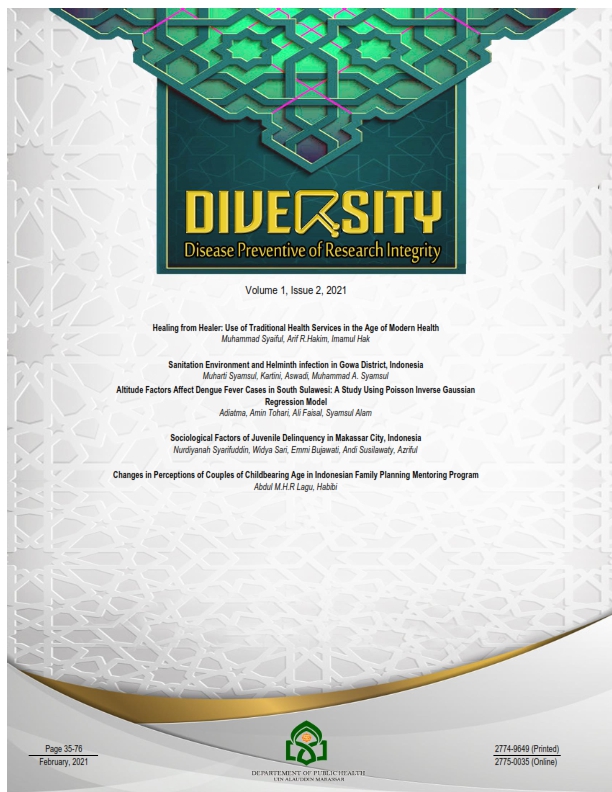Altitude Factors Affect Dengue Fever Cases in South Sulawesi: A Study Using Poisson Inverse Gaussian Regression Model
Abstract
Poisson regression is used to model enumeration data such as data on the number of DHF cases. This model has the assumption that is fulfilled is the average and the variance must have the same value or it is called the equidispersion. But this assumption is not fulfilled because the data on the number of dengue cases experienced violations of this assumption. The violation is that the average value is smaller than the variance value or it is called overdispersion. This results in incorrect conclusions because the prediction standard error is underestimated. The way to prevent this is by combining the Poisson distribution and discrete or continuous distribution, this combination is called Mixed Poisson Distribution. Researchers use one of the Mixed Poisson methods, namely Inverse Gaussian Poisson Regression (PIG) because the method is used when the data is overdispersed and the parameters are known or close form on the likelihood function. Based on the results of the study, it is known that the height of the area is a factor that significantly influences DHF cases in South Sulawesi.

Downloads
References
Badan Penelitian dan Pengembangan Kesehatan. (2018). Laporan Riset Kesehatan Dasar.
Brady, O. J., Golding, N., Pigott, D. M., Kraemer, M. U., Messina, J. P., Reiner Jr, R. C., ... & Hay, S. I. (2014). Global temperature constraints on Aedes aegypti and Ae. albopictus persistence and competence for dengue virus transmission. Parasites & vectors, 7(1), 1-17.
Cheong, Y. L., Leitão, P. J., & Lakes, T. (2014). Assessment of land use factors associated with dengue cases in Malaysia using Boosted Regression Trees. Spatial and spatio-temporal epidemiology, 10, 75-84.
Harapan, H., Michie, A., Mudatsir, M., Sasmono, R. T., & Imrie, A. (2019). Epidemiology of dengue hemorrhagic fever in Indonesia: analysis of five decades data from the National Disease Surveillance. BMC research notes, 12(1), 1-6.
Harris, T., Yang, Z., & Hardin, J. W. (2012). Modeling underdispersed count data with generalized Poisson regression. The Stata Journal, 12(4), 736-747.
Herindrawati, A. Y. (2017). Pemodelan Regresi Poisson Inverse Gaussian (Studi Kasus: Jumlah Kasus Baru HIV Di Provinsi Jawa Tengah Tahun 2015) [Doctoral dissertation, Institut Teknologi Sepuluh Nopember].
Jayarajah, U., Dissanayake, U., Abeysuriya, V., De Silva, P. K., Jayawardena, P., Kulatunga, A., ... & Seneviratne, S. L. (2020). Comparing the 2009 and 1997 World Health Organization dengue case classifications in a large cohort of South Asian patients. The Journal of Infection in Developing Countries, 14(07), 781-787.
Kurniawati, I., Susilawaty, A., Habibi, H., & Amansyah, M. Dengue Fever Case Management in Maros Regency, Indonesia. Diversity: Disease Preventive of Research Integrity, 1(1), 8-14.
Lagu, A. M. H., Damayati, D. S., & Wardiman, M. (2017). Hubungan jumlah penghuni, jumlah tempat penampungan air dan pelaksanaan 3M plus dengan keberadaan jentik nyamuk Aedes sp di Kelurahan Balleangin Kecamatan Balocci Kabupaten Pangkep. HIGIENE: Jurnal Kesehatan Lingkungan, 3(1), 22-29.
Liu, K., Sun, J., Liu, X., Li, R., Wang, Y., Lu, L., … Liu, Q. (2018). Spatiotemporal patterns and determinants of dengue at county level in China from 2005–2017. International Journal of Infectious Diseases, 77, 96–104.
Nejati, J., Bueno-Marí, R., Collantes, F., Hanafi-Bojd, A. A., Vatandoost, H., Charrahy, Z., … Sedaghat, M. M. (2017). Potential Risk Areas of Aedes albopictus in South-Eastern Iran: A Vector of Dengue Fever, Zika, and Chikungunya. Frontiers in Microbiology, 8. doi:10.3389/fmicb.2017.01660
Nuraeni, N. (2018). Pemodelan Jumlah Kematian Bayi di Sulawesi Selatan Menggunakan Regresi Poisson Inverse Gaussian (Doctoral dissertation, Pascasarjana).
Ramadhan, M. N. (2019). Pemodelan Jumlah Penyakit Kusta Di Provinsi Sulawesi Tenggara Menggunakan Metode Regresi Poisson Inverse Gaussian [Doctoral dissertation, Muhammadiyah University, Semarang].
Shihab, M. Q. (2000). Tafsir Al-Mishbah: pesan, kesan dan keserasian Al-Qur’an. Lentera Hati.
Sirisena, P. D. N. N., & Noordeen, F. (2014). Evolution of dengue in Sri Lanka—changes in the virus, vector, and climate. International Journal of Infectious Diseases, 19, 6-12.
Susilawaty, A., Lagu, A. M. H., Basri, S., Maisari, U., & Amansyah, M. (2018). Penilaian Risiko Sanitasi Lingkungan di Pulau Balang Lompo Kelurahan Mattiro Sompe Kecamatan Liukang Tupabbiring Kabupaten Pangkajene dan Kepulauan. Al-Sihah: The Public Health Science Journal, 10(2).
Verma, R., Sahu, R., & Holla, V. (2014). Neurological manifestations of dengue infection: a review. Journal of the neurological sciences, 346(1-2), 26-34.
Copyright (c) 2021 Adiatma, Amin Tohari, Ali Faisal, Syamsul Alam

This work is licensed under a Creative Commons Attribution-NonCommercial-ShareAlike 4.0 International License.
Authors retain copyright and grant the journal right of first publication with the work simultaneously licensed under a Creative Commons Attribution-NonCommercial-ShareAlike 4.0 International License that allows others to share the work with an acknowledgment of the work's authorship and initial publication in this journal.
Authors are able to enter into separate, additional contractual arrangements for the non-exclusive distribution of the journal's published version of the work (e.g., post it to an institutional repository or publish it in a book), with an acknowledgment of its initial publication in this journal.
Authors are permitted to publish their work online in third parties as it can lead to wider dissemination of the work.




